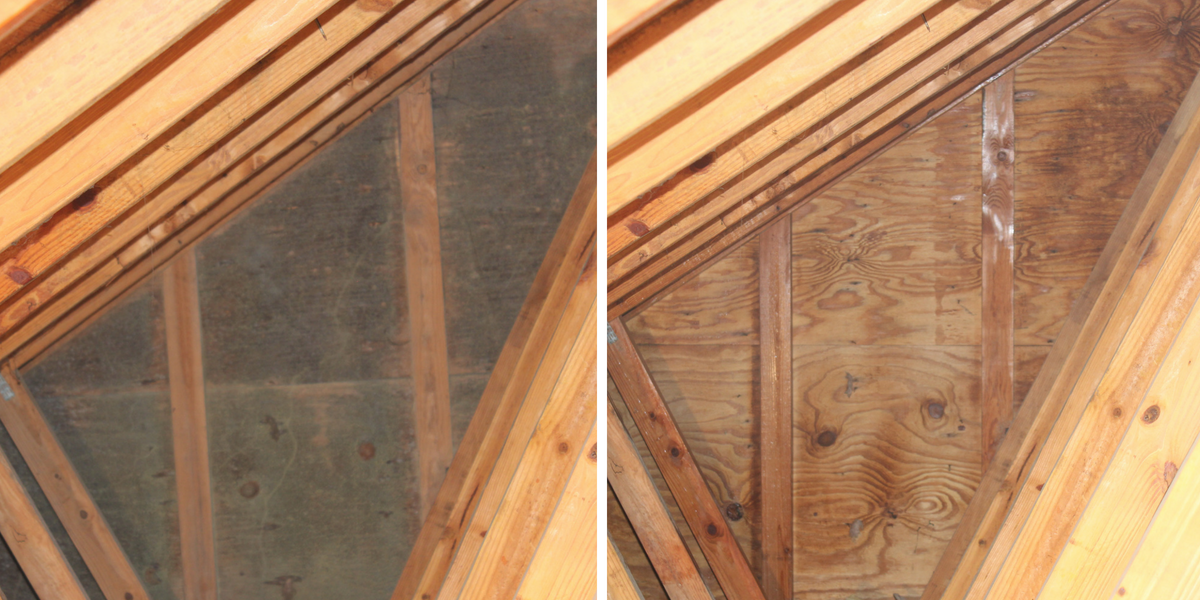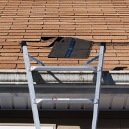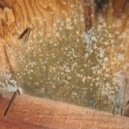Find a pre-screened local mold removal specialist Free Estimate
Find a Mold Specialist Now
Click or Call, Toll-Free 24/7
How to Prevent Attic Mold
From Returning
So you've found mold in your attic. Now what? Let's figure out why you have a moldy attic and how you can prevent it from happening again.
It may seem counterintuitive because most people link mold to humidity, but mold usually grows in attics that experience cold temperatures. This is because most condensation occurs when the attic is cold, the house is cozy, and air ducts and vents are blowing warm air into and around the attic. Condensation builds up, and, before you know it, mold spores have found their happy place to set up shop and grow.
Luckily, with a little sleuthing, you'll be able to discover what's causing the condensation and how to prevent it from happening again.
Most Common Attic Molds
Although there are many kinds of molds, from pink molds, yellow molds, and even blue-green molds, the molds you'll usually find in the attic are black or white molds.
Black mold is the most common type of mold and usually occurs in spaces where there is moisture build-up and little to no ventilation—think bathroom mold.
White mold is the other common mold type found in attics. It can be difficult to spot as some attics have salt build-up from water seepage that presents similarly. However, if you find a white build up on wood or drywall, there's a good chance it's mold.
Both white and black mold can cause coughing, itchy eyes, and other allergy-like symptoms in healthy people, but isn't deadly to be around. If you have allergies or a condition that makes you more sensitive to airborne contaminants, you should check with your doctor for their recommendations. Either way, it's best to clean it up as soon as possible.
What Causes Attic Mold?
The most common cause of attic mold is inadequate ventilation. When there is not enough air circulation in the attic and moisture accumulates, the moisture doesn't evaporate and instead creates a damp, dark environment—perfect for mold growth.
This lack of ventilation is compounded by the addition of condensation. For instance, if your bathroom vent, dryer vent, or any other appliance's vent empties into the attic, then you are filling the attic with moist air every time you take a shower or use your appliances. When your attic doesn't have the proper ventilation, that moisture becomes a breeding ground for mold.
The top seven causes of attic mold are:
- Inadequate air ventilation
- Improperly vented appliances (and bathrooms)
- Improperly installed furnaces or water heaters
- Uninsulated air ducts
- Open plumbing vents
- Roof leaks
- Improper insulation of skylights, attic floor, access panels or ceiling penetrations
How to Prevent Attic Mold
First, you have to ascertain where the moisture is coming from and fix whatever venting or insulation issues you find. Then you should ensure your attic has enough ventilation to prevent moisture from building up again.
Proper Insulation Installation
Insulation should prevent warmer air from penetrating into the colder attic, which will cause condensation and moisture build up. Check that there is insulation:
- On and surrounding your access panel (the pull-down stairs or utility hole you use to enter the attic)
- Surrounding your skylight chases
- On the attic floor, or, if you have finished attic floors, between your attic floor and living quarter's ceiling.
- In any empty wall spaces between the attic and other parts of the house (crawl space, open chases, etc.)
- Surrounding heating ducts
Proper Venting
All of your appliance, plumbing, and house vents should vent to the outside, not to your attic. If your bathroom, stove, or dryer does vent to the attic, you'll probably see a metal or plastic pipe that cuts off before it reaches the ceiling of the space. If you don't see any pipes, turn on your venting appliances and the bathroom vent to follow the noise and find them. The vents may be hidden under your floor insulation.
There is also a chance that your vents might be venting to vent ports installed in the soffit. While this is the preferred method in some building codes, the warm air doesn't naturally want to travel in the downward motion these soffit vents require, so it may instead be moving back up and causing moisture build-up. Check for stains and discoloration above where the vent enters the soffit area to diagnose possible venting problems.
Each appliance and vent should have it's own dedicated port to transport the hot air outside. However, because dryer vents require periodic cleaning, you'll want to easily access the inside of the pipe to remove any lint build up, therefore, your dryer vent should have a removable section of pipe in the attic area.
Proper Appliance Installation
If you have a furnace or water heater installed in your attic, it must be contained in a room separated from the open attic. There may even be additional code requirements in your area that state that any vent pipes from furnaces or water heaters that enter the attic must be double-wall pipes. Check your code requirements not only to prevent condensation build-up but also to ensure your furnace or water heater is safely installed.
Proper Roof Installation
Roof leaks are another cause of moisture collection in the attic. Check for areas on your attic's ceiling that appear to have water damage, then examine the corresponding areas of the roof for raised shingles or other potential integrity problems.
Proper Ventilation
Even if you have some moisture and condensation in your attic, it can be mitigated by having adequate ventilation to evaporate the water molecules. Most attics have ventilation either through soffit vents, gable vents, or roof vents.
First, check to see if the vents are clear. If your house is surrounded by trees and bushes, the vents may be filled with debris. If so, clean them out and schedule a time to check and clean your vents periodically.
If your attic isn't getting enough airflow and your vents are clear, increase the size or amount of venting to allow more air to flow through your attic. If you can't get the proper airflow through passive vents, you may need to invest in ventilation fans.
It's best to invest in a fan system that is hardwired and uses a humidity sensor or thermostat to trigger its motor. This ensures that the fan only works when it's needed. The fans are designed to fit into your attic wall (usually in the place of an existing gable vent) or in a hole cut into the roof and connected to your house's wiring.
Choosing the proper vent fan rating (how much air the fan moves per minute) depends on the size of your attic and the angle and color of your roof. Because the type of fan you get also depends on the number and placement of your passive vents, it may be best to consult a professional when planning to install an attic fan.
Using this list of causes and potential fixes, hopefully, you'll be able to easily discover and mitigate the culprit(s) to your mold problem.
Finding and fixing the cause of your mold problem doesn't get rid of the mold that you've already found in your attic. If the affected area is more than 10 square feet, then you should contact a professional to identify and remove the mold. Otherwise, you can remove the mold yourself (wearing the proper personal protection including a face mask to prevent inhalation of mold spores). Most professionals will give you a free inspection and estimate. Even if you are planning on removing the mold yourself, you should still have a professional come in and get their advice.
Return From How To Prevent Attic Mold To Our Main Prevention Page
About The Authors:
RMR Solutions, LLC is the manufacturer of RMR-86 Mold Stain Remover, which has changed the way mold remediation is done. They have developed their products based on client’s needs. If you’re looking to kill, clean and prevent mold & mildew growth, their products surpass all industries standards. They pride themselves on bringing the best products for the lowest price to everyone.
Free Home Inspection By A Mold Removal Specialist
Search This Website
Recent Articles
-
See Our 5 Recommended Mold Removal Companies in Covington, KY
Apr 16, 25 12:59 PM
-
See Our 5 Recommended Mold Removal Companies in Wheaton, IL
Jun 20, 24 10:33 AM
-
See Our 5 Recommended Mold Removal Companies in Aberdeen, SD
Oct 08, 21 04:05 PM





